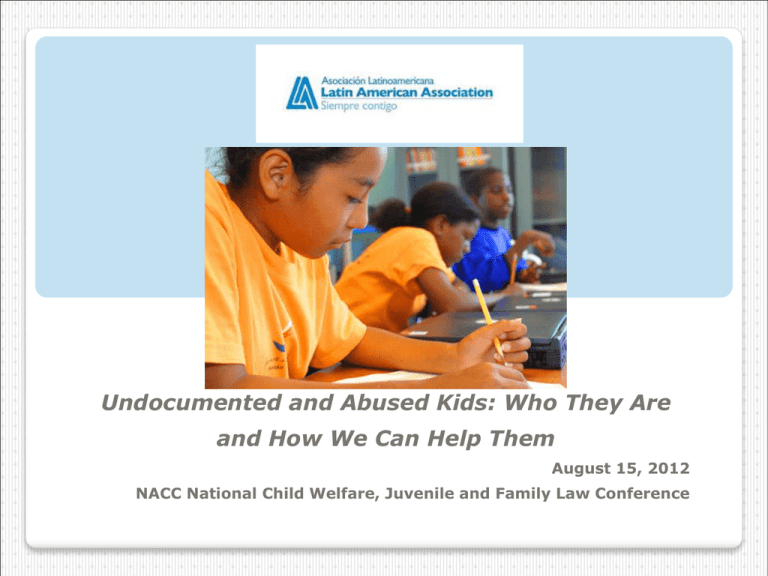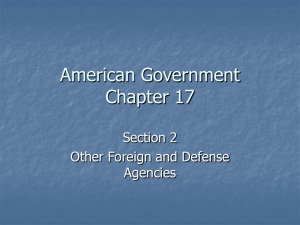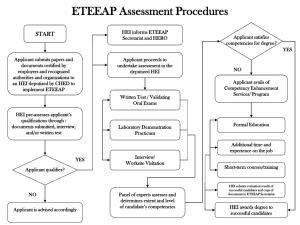
Undocumented and Abused Kids: Who They Are
and How We Can Help Them
August 15, 2012
NACC National Child Welfare, Juvenile and Family Law Conference
•The LAA offers programs and services for Latino and non-Latino clients
designed to empower them to achieve academic, social and economic
advancement.
•Programs offered include: community & family services, employment
services, youth programs, ESOL and other educational programs, Spanish
classes, translation services and immigration services.
•The Immigration Services Department assists indigent immigrant clients with
family petitions, domestic violence cases, applications to adjust status to
permanent resident, citizenship, waivers of inadmissibility, asylum,
immigration cases of juveniles and defense in immigration removal
proceedings.
The Latin American Association
2750 Buford Highway NE Atlanta, GA 30324
404-471-1889 (Immigration Services)
Undocumented & abused kids:
who are they?
1) Children who have just arrived in the US and who enter without
lawful documents (“EWI”)
The Homeland Security Act of 2002 (“HSA”) reorganized federal
responsibilities for juvenile aliens. Prior to the HSA, the former
INS was responsible for apprehending and detaining all juvenile
aliens. The Homeland Security Act of 2002 created the
Department of Homeland Security (“DHS”).
DHS has assigned juvenile responsibilities to the Bureaus of
Immigration and Customs Enforcement (“ICE”) and Customs and
Border Protection (“CBP”). Both were given responsibility for
apprehending, processing, and transporting all juvenile aliens.
Office of Refugee Resettlement (“ORR”), a section of the U.S.
Department of Health and Human Services, was assigned
responsibility for caring and housing unaccompanied juvenile
aliens who are detained by DHS pending resolution of
immigration cases enforced by DHS.
Federal responsibilities for
juvenile immigrant children
•In FY 2010, CBP reports that it apprehended approximately 29,624
minor children along US borders, and that 59% of these children
were unaccompanied minor children (“UAC”).
•In FY 2011, the total number of minor children apprehended
declined to around 22,892 minor children. However, 70% of these
minor children were UACs.
•“Unaccompanied”: a non-citizen who
•Does not have lawful immigration status in the US;
•Is under the age of 18;
•And for whom
•There is no parent or legal guardian in the US; or
•There is no parent or legal guardian in the US who is willing
and able to provide care and physical custody.
Undocumented children in the US
A look at the numbers
• 8 U.S.C. 1232(a)(2) : unaccompanied children from contiguous countries
(Mexico & Canada) repatriated upon apprehension upon determination that
•The child has NOT been a victim of a severe form of trafficking and there is no
credible evidence that child will be at risk of being trafficked if returned
•The child does NOT have a fear of returning to country of origin
•The child IS able to make an independent decision to withdraw his/her
application for admission to the US.
•The child IS inadmissible to the US
Undocumented children in the US
Special repatriation rules for unaccompanied Mexican and Canadian
minor children
•Unaccompanied minor children not repatriated upon apprehension are
placed in the custody of ORR, Division of Unaccompanied Children’s
Services (“DUCS”) until the child can be placed with a family member or
friend or reunified with a parent, if possible.
•According to the ORR, about 77% of children in their custody are male
and 23% are female. The majority of UACs in custody are 14-17 yrs. old
and 17% of kids in their care are under the age of 14.
•Most common native countries of UACs in FY 2011:
•Guatemala: 36%
•El Salvador: 25%
•Honduras: 20%
•Mexico: 12%
•Ecuador: 3%
•Other: 4%
Undocumented children in the US
Unaccompanied minor children and the ORR reunification process
•Seeking reunification with family members
•Example: El Salvador
•Estimated 40% of population lives in poverty
•Approximately 70,000 persons emigrate annually seeking employment abroad
•For exploitive purposes, including trafficking
•14,500-17,500 foreign nationals are estimated to be trafficked into the US each year; the
majority of these persons are female and under the age of 18.
•Top countries of origin for victims are Mexico, the Philippines, Thailand, Guatemala,
Honduras and India.
•Escaping war, famine, persecution
•It’s estimated that over half of the world’s estimated 20 million refugees and internally
displaced persons are children.
•2-5% of these children (up to 1 million) are children separated from their parents.
•Escaping abuse, abandonment and neglect in their home countries
Undocumented children in the US
Why do children come unaccompanied by a parent or adult to the
US?
•Many children travel to the US with a parent or legal guardian. These
children may have EWI-ed when they were very young or they may have
entered lawfully on a non-immigrant status (i.e. with a visitor’s visa) and
stayed past the time they were authorized to remain in the US.
•Undocumented immigrants in US estimated to be around 11.5 million.
•DHS doesn’t have a way to track those who overstay visas.
•Pew Hispanic Center estimated in 2006 there were 4-5.5 million people in US
who overstayed their visas.
Undocumented & abused kids:
who are they?
2) Children who entered the US with a parent or legal guardian,
either EWI or with a non-immigrant visa, years ago and are later
abused.
•Special Immigrant Juvenile Status (SIJ) for child abuse,
abandonment and neglect victims
•U nonimmigrant status for victims of certain crimes
•Violence Against Women Act (VAWA) relief for domestic
violence victims
•T nonimmigrant status for victims of Human Trafficking
•Asylum relief for individuals persecuted on account of
their race, religion, nationality, political opinion or social
group
...so how do we help them?
Protection for 1) children who 2) do not have lawful status
3) who have been abused, abandoned or neglected in the
U.S. or abroad and 4) for whom parental reunification is not
viable.
Applies to children who have just crossed the border as unaccompanied
minors.
Applies to children who were brought here by family members and grew
up in the United States.
This individual form of protection.
This status requires interplay of federal immigration law,
international treaty law and 50 different state child
welfare codes.
What is Special Immigrant
Juvenile Status (SIJS)?
In 1990, Representative Morrison introduced legislation in the House of
Representatives (H.R. 4300) that created SIJS.
This became law through the Immigration Act of 1990.
William Wilberforce Trafficking Victims Protection Reauthorization Act
of 2008 (TVPRA) made major changes to SIJS eligibility, changing the
language needed in state juvenile court orders for SIJS eligibility.
Notably, it also 1) created 180-day timeline for SIJS petitions to be
adjudicated and 2) sought to prevent age-outs; as long as the child files
while s/he is under a valid juvenile court order (in Georgia, by age 18).
BRIEF HISTORY OF SIJS:
IMMIGRATION AND NATIONALITY ACT
AND THE TVPRA
William Wilberforce Trafficking Victims
Protection Reauthorization Act of 2008
Section 235 of TVPRA …Effective date: March 23, 2009
•
SIJS must be adjudicated within 180 days!
•
Prevents age-outs
• File by 18- age frozen
•
•
Still in proceedings – grandfathered (effective December 23, 2008)
Changes the Juvenile Court Order requirements from ‘long term foster
care’ to ‘reunification with 1 or both parents not viable’
TVRPA Clarified intentions of Congress in protecting
vulnerable foreign born children and enhanced efforts to
combat trafficking and ensure safe repatriation when
appropriate
•
Secretary of State shall negotiate agreements between the U.S. and
contiguous countries with respect to repatriation procedures
•
No child shall be returned to the child’s country of nationality or of
last habitual residence unless returned to appropriate employees or
officials [through proper diplomatic channels]
•
Implement best practices to ensure safe and sustainable repatriation
and reintegration
• Determinations include assessment of country conditions through
Department of State’s Country Reports on Human Rights
Practices and the Trafficking in Person’s Report
•
•
•
•
•
•
•
SPECIFICALLY
WAIVED
Public Charge
Labor Certification
Present without admission or
Parole (without inspection)
Stowaway
Misrepresentation/ Fraud
Lack of Valid Entry
Document
Unlawful Presence
•
•
•
•
•
•
•
WAIVABLE
Health related grounds
Prostitution and
commercialized vice
Alcoholics or people with
“mental, physical disorders”
Drug addicts or abusers
Association with terrorist
organization
Immigration violators
Aliens previously removed
William Wilberforce Trafficking Victims
Protection Reauthorization Act of 2008
NOT WAIVABLE
• Certain crimes (aggravated felonies)
• Multiple criminal convictions
• Controlled substance traffickers
• Terrorist activities
William Wilberforce Trafficking Victims
Protection Reauthorization Act of 2008
Sec 235(d)(4)(A) provides:
◦
◦
◦
STATE REIMBURSEMENTS!!
Increases access to federal funds for state agencies providing services
under section 501(a) of Refugee Education Assistance Act of 1980
Makes eligible for placement and services under INA 412(d), in parity
with refugee children
Title IV federal financial assistance
Sec 235(d)(4)(B) provides:
DFCS REIMBURSEMENTS!!
◦
“[s]ubject to the availability of appropriations,” the federal government
shall reimburse the state for state foster care funds expended on behalf
of children granted Special Immigrant Juvenile Status.
William Wilberforce Trafficking Victims
Protection Reauthorization Act of 2008
Under the age of 21 (8 CFR §204.11(c)(1))**
Unmarried (8 CFR §204.11(c)(2))
Declared dependent on a juvenile court located in the United States or
whom such a court has legally committed to, or placed under the custody
of, an agency or department of a State, or placed under guardianship (INA
§101(a)(27)(J))
Whose reunification with 1 or both of the immigrant’s parents is not viable
due to abuse, neglect, abandonment, or a similar basis found under State
law. (INA §101(a)(27)(J))
For whom it has been determined in administrative or judicial proceedings
that it would not be in the child’s best interest to return to her home
country (INA §101(a)(27)(J))
SIJS eligibility: 5 basic requirements
BASIC LAW OF SIJS:
FIVE BASIC REQUIREMENTS
Under the age of 21
While the federal eligibility criteria
extend to age 21, in the state of Georgia,
juvenile court extends to age 18.
It may be possible to raise arguments for
extension of jurisdiction in special
cases.
TVRPA resolved this
REQUIREMENT ONE
Unmarried
A child’s having his/her own children is not a bar to SIJS.
REQUIREMENT TWO
Deprived under State Law
Declared dependent on a juvenile court located in the United States or
whom such a court has legally committed to, or placed under the custody
of, an agency or department of a State (INA §101(a)(27)(J))
◦ Deprived under Georgia Law §15-11-8
Child could be in Independent Living Program, long-term foster care
placement, Permanent Guardianship situation, group home, placed
with non-parent relative or living with court-appointed guardians.
REQUIREMENT THREE
Reunification with parent not viable
Whose reunification with 1 or both of the immigrant’s parents is not
viable due to abuse, neglect, abandonment, or a similar basis found under
State law. (INA §101(a)(27)(J))
◦ Does not require the court to address both parents, one will do
Caution: if one parent still caring
for child – not going to work!
◦ Does not require termination
of parental rights
REQUIREMENT FOUR
Best interest to remain in current
placement
It has been determined in
administrative or judicial
proceedings that it would
not be in the child’s
best interest to return
to her home country
or last habitual residence
REQUIREMENT FIVE
1.
State Dependency Proceedings
2.
File Immigration paperwork (“1-step”)
1.
2.
Child will have two appointments with Immigration
3.
1.
2.
4.
Form I-360, I-485, I-765 and I-912 (fee waiver)
If child is 14 years old or older, also must file Form G-325A
Supporting documents to include: state adjudicatory order, child’s birth certificate, with
certified English translation, passport with proof of lawful entry (if applicable) and medical
exam.
Biometrics appointment
Adjustment of Status interview before USCIS officer
LPR (“green card” granted)
-- within 180 days of filing
4.
Age 18 and if LPR 5 years -- apply for citizenship
OVERVIEW OF THE SIJS PROCESS:
NOT IN REMOVAL
Concurrently
1.
-- Child must attend ALL Immigration Hearings
-- Dependency Proceedings in State Court
2.
File Immigration paperwork (“1-step”) and file motion
with Immigration Court to end removal proceedings
3.
Child will have two appointments with Immigration
1.
2.
4.
Biometrics appointment
Adjustment of Status interview before USCIS officer
LPR (“green card” granted)
-- within 180 days of filing
4.
Age 18 and if LPR 5 years -- apply for citizenship
OVERVIEW OF THE SIJS PROCESS:
IN REMOVAL PROCEEDINGS
◦ The child must remain under juvenile court jurisdiction
at the time the I-360 is filed with USCIS
CAUTION
Provides immigration protection to
victims of certain types of crimes
Congress wanted to aid law
enforcement in investigating and
prosecuting crime by providing a
way for undocumented immigrant
victims to remain in the US to assist
in an investigation or prosecution
U Nonimmigrant Status (U visa)
What crimes qualify?
Rape
Torture
Trafficking
Incest
Domestic violence
Sexual assault
Abusive sexual conduct
Prostitution
Sexual exploitation
Female genital mutilation
Being held hostage
Peonage
Involuntary servitude
Slave trade
Kidnapping
Unlawful criminal restraint
False imprisonment
Blackmail
Extortion
Manslaughter
Murder
Felonious assault
Witness tampering
Obstruction of justice
*Includes attempts, conspiracy, or solicitation.
*Includes any similar activity where the nature and elements of the unlisted
crime are substantially similar.
In order to be eligible for a U visa a victim must:
Be a victim of qualifying criminal activity and suffered substantial
physical or mental abuse as a result of the crime.
Possess information about the qualifying criminal activity.
Have been, is being, or is likely to be helpful to the investigation and/or
prosecution of that qualifying criminal activity.
Be a victim of criminal activity that violated a U.S. law.
Eligibility Requirements
• Form I-918B
•
•
Certifying official must be a Federal, State or local law enforcement agency,
prosecutor or authority, or Federal or State judge with the responsibility for the
investigation or prosecution, conviction or sentencing of the qualifying
criminal activity.
*Child Protective Services is one of the enumerated agencies that can
complete and sign a U-visa certification!!!*
• Must certify that the applicant:
•
•
•
•
Is a victim of a qualifying criminal activity;
Possesses information about the qualifying crime;
Was helpful in the investigation or the prosecution of the crime; and that
The qualifying crime occurred in the US or in a US territory.
Filing a U-visa
Step 1) Obtaining a U-visa law enforcement certification
• Fill out Form I-918 for principal applicant completely,
including supporting documents such as
•
•
•
•
•
•
•
No filing fee
Personal statement from applicant describing the crime of which s/he was a victim, including how
this crime affects him/her physically, emotionally and psychologically, with certified English
translation (if needed)
Police reports, hospital records, psychological treatment records (if applicable)
Indictment, charging document, court records (if applicable)
Letters from friends/relatives (*must be LPRs or USCs) with personal knowledge of crime and its
affects on applicant
Copy of applicant’s birth certificate, biographic page of passport, cédula or other government-issued
ID, with certified English translation (if needed)
Copy of applicant’s passport, with proof of lawful entry (if applicable)
• Family members that qualify for derivative status include:
•
•
•
•
Applicant’s spouse
Applicant’s child
Applicant’s parent
Applicant’s unmarried sibling under age 18
Filing a U-visa
Step 2) Complete Form I-918, with Forms I-918A for any qualifying
derivative family members
• If applicant did NOT enter the US lawfully (i.e. with a valid
visa, border crossing card or other document), s/he will need to
complete a Form I-192, Application for Advance Permission to
Enter as a Non-immigrant.
•
•
$585 filing fee (*Fee waivers available)
Submit a personal statement, with certified English translation, if necessary,
from applicant about how s/he would suffer if I-192 were not approved and
s/he were returned to home country
• Educational, medical, work opportunities in home country
• Resources available in home country to crime survivors
• Stigma in home country of being crime survivor
• Possibilities of re-victimization
• Derivatives with unlawful entries also must complete I-192
Filing a U-visa
STEP 3) Complete an I-192 (if necessary)
Can apply for family members
Eligible to work in the US
4 year duration of status (extensions are available)
Can adjust status to lawful permanent resident
Benefits
Provides immigration relief to victims of domestic
violence
Congress recognized that immigrant victims of
domestic violence may remain in an abusive
relationship because immigration status is often tied
to their abuser.
VAWA is a “self-petitioning” relief that removes
control from the abuser and allows the victim to
submit his or her own application that are filed
without the abuser’s knowledge or consent.
Violence Against Women Act (VAWA)
Who may file?
Spouses - The abused spouse of a USC/LPR (child may be
included as a derivative beneficiary)
Children - The abused child of a USC/LPR
Parents – The abused parent of a USC (added by VAWA 2005)
VAWA immigration relief applies equally to women and men
◦ Including: The spouse of a USC/LPR whose child has been abused may
file a self-petition based on the abuse of the child. In this case, the parent
files based on abuse of the child, but both parent and child benefit.
(this gender neutrality was reiterated by VAWA 2005)
Who Qualifies?
Is or was married to USC or LPR
Is child of USC or LPR
Is parent of USC
Marriage was in good faith
Subjected to battery or extreme cruelty during the
marriage
Resides or Resided with the abuser
Good moral character
Eligibility Requirements
Fill out Form I-360 completely, with supporting
documents, such as
◦ No filing fee
◦ Personal statement from applicant about her personal history and the abuse
suffered, with certified English translation (if needed)
◦ Proof of US citizenship or LPR status of abuser
◦ Marriage certificate (if spouse is abuser)
◦ Proof of divorce of prior marriage(s) of abuser and/or applicant (if spouse is
abuser)
◦ Evidence that the abuser and applicant resided together
◦ Proof marriage was in good faith (if spouse is abuser)
◦ Evidence of applicant’s good moral character
◦ Proof of the abuse
Filing a VAWA application
Can work in the US
Changes to the abuser’s immigration status will not
affect the victim’s self-petition
Remarriage after approval does not affect status
Can adjust status to lawful permanent resident
Benefits
Provides immigration protection to victims of human
trafficking
Congress wanted to aid law enforcement in investigating
and prosecuting human trafficking by providing a way for
undocumented immigrant victims to remain in the US to
assist in an investigation or prosecution
What is trafficking?
◦ Modern day form of slavery
◦ migrant workers, sweatshops, sex trade, domestic servitude
T Nonimmigrant Status (T visa)
Trafficking v. Smuggling
Smuggling
Trafficking
Purpose
Obtain illegal entry into Recruiting, transporting,
the US
harboring or receipting persons
by force or coercion for the
purpose of exploitation
Consent
Consent to be
smuggled
May or may not have
consented, or initial consent
rendered meaningless by
coercive or abusive actions of
the traffickers
Result
Ends with arrival into
the US
Involves ongoing exploitation
In order to be eligible for a T visa a victim must:
Be a victim of a severe form of trafficking in persons.
Be physically present in the United States.
Comply with any reasonable requests for assistance in the
investigation or prosecution (or be under the age of 18 or
cannot participate due to trauma).
Suffer extreme hardship involving unusual and severe harm
upon removal from the United States.
Eligibility Requirements
• Form I-914B
• Completed by a Federal, State or local law enforcement agency,
prosecutor or authority, OR Federal or State judge with responsibility
for the investigation or prosecution, conviction or sentencing of the
trafficking in persons
• Agency must certify that the applicant:
• Was the victim of a severe form of trafficking
•
“Severe form of trafficking” includes sex trafficking, forced labor, involuntary
servitude, peonage, debt bondage and slavery
• Cooperated with reasonable requests from Federal, State or local
law enforcement in the investigation or prosecution of the acts of
trafficking of which s/he was a victim
•
An applicant does NOT have to meet this requirement if under the age of 18!
Filing a T-visa
STEP 1) Obtaining a T-visa law enforcement certification
• Fill out I-914 completely for principal applicant, including
supporting documentation, such as
•
•
•
•
•
•
No filing fee
Personal statement from applicant with certified English translation (if needed)
Copies of police reports (if any)
Copies of court indictments, victim’s advocate statements, etc. (if any)
Applicant’s birth certificate, biographic page of passport, cédula or other
government-issue ID with certified translation (if needed)
Applicant’s passport with proof of lawful entry (if applicable)
• Family members that qualify for derivative status include:
•
•
•
•
Applicant’s spouse
Applicant’s child
Applicant’s parent
Applicant’s unmarried sibling under age 18
Filing a T-visa
STEP 2) Complete Form I-914, with Forms I-914A for any qualifying
derivative family members
• If applicant did NOT enter the US lawfully (i.e. with a valid
visa, border crossing card or other document), s/he will need to
complete a Form I-192, Application for Advance Permission to
Enter as a Non-immigrant.
•
•
$585 filing fee (*Fee waivers available)
Submit a personal statement, with certified English translation, if necessary,
from applicant about how s/he would suffer if I-192 were not approved and
s/he were returned to home country
• Educational, medical, work opportunities in home country
• Resources available in home country to trafficking survivors
• Stigma in home country of being trafficking survivor
• Possibilities of re-victimization
• Derivatives with unlawful entries also must complete I-192
Filing a T-visa
STEP 3) Complete an I-192 (if necessary)
Can apply for family members
Eligible to work in the US
4 year duration of status (extensions are available)
May adjust status to lawful permanent resident
Benefits
How does one qualify for asylum?
◦ Applicant must show that s/he meets the definition of
“refugee”
◦ Refugee = Person who is “unwilling or unable to return” to
his/her country of nationality or last habitual residence
because of past persecution or a “well-founded fear” of
future persecution on account of race, religion, nationality,
membership in a particular social group or political
opinion. INA §101(a)(42), §208(a).
Generalized fear of return due to high crime rates or deteriorating country conditions
often do NOT qualify an applicant as a “refugee” under this definition!
Asylum
What is “persecution”?
◦ Applicant must also show “Either a threat to the life or
freedom of, or the infliction of suffering or harm upon,
those who differ in a way regarded as offensive.” Matter of
Acosta, 19 I&N Dec. 211 (BIA 1985).
◦ On account of: race, religion, nationality, membership in a
particular social group, or political opinion
Asylum
Persecution by
whom?
◦ The Government or a person or group that the
Government is unwilling or unable to control
◦ *Applicant must also show that s/he cannot
relocate within his/her country of origin.
Asylum
What
constitutes a “particular social group”?
◦ Group of people who share a common, immutable (innate)
characteristic (e.g. color, kinship, shared experience)
◦ Must be able to define your group (must be “particular”)
and group must be “socially visible”
◦ No clear definition of what is and is not a “particular social
group”
Asylum
Asylum is NOT easy to win and a grant of asylum is
discretionary!
◦ Denial factors: e.g. length of time person lived in a third
country; commission of serious fraud to circumvent orderly
immigration procedures
◦ In most cases (i.e. with adults and accompanied minor
children), asylum claims must be filed within 1 year of
arrival to the US!
1-year deadline waived with unaccompanied minor children
May also be waived if can show that extraordinary
circumstances prevented timely filing
Asylum
How does one apply for asylum?
◦ Affirmatively: file Form I-589 with US Citizenship and Immigration
Services (USCIS) if applicant is not in removal proceedings
◦ Defensively: file Form I-589 before Immigration Judge if applicant is in
removal proceedings
Form I-589 needs to be filled out completely, with supporting documentation
of persecution!
What are examples of supporting documents?
◦ Personal statement from applicant, with certified English translation (if needed)
◦ Country condition reports
◦ Medical/psychological evaluation(s)
◦ Affidavits from witnesses
◦ Expert evaluations
Asylum
Can live and work in the U.S.
Can petition for derivative family members (spouse
and children under 21)
Can file for legal permanent residence status and
eventually U.S. citizenship.
Benefits of asylum
•You are a volunteer attorney who is called to meet with Mario, a 15-year-old boy who is
scheduled to appear in a delinquency hearing before your county’s juvenile court. When you meet
with Mario, you learn that he was arrested late one evening by a police patrol for loitering. Mario
was also intoxicated at the time of his arrest. When the police officer asked Mario where his
parents were, Mario was unresponsive. Mario reveals to you that his parents are both in
Honduras; Mario states that an uncle molested Mario throughout his childhood, and that, when
he reported it to his parents, they never called the police and continued to allow the uncle to visit
the home. Mario says he decided to come to the US when he was 13 in order to escape the abuse
and to live with his sister, who had immigrated to the US when Mario was 7. Mario said that he
met a “guia”, or “guide” in his hometown who agreed to assist Mario in traveling to the US.
Mario says that this guide charges $10,000, but because Mario did not have the money he agreed
to let Mario pay him back once Mario arrived in the US. Upon arriving, associates of the guide
told him that he must work for them to pay back his debt. Mario reveals that he works as a
prostitute, and that he was working the night he was arrested. He did not tell the arresting officer
because he was afraid and ashamed. Mario’s sister resides in a nearby town, but he feels that he
must first work off his debt to the guide before he can attempt to find her. Mario is frightened and
does not want to return to Honduras. Does Mario qualify for any immigration remedies?
Case study
How can we help?










